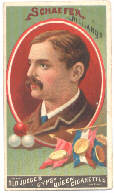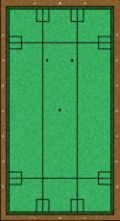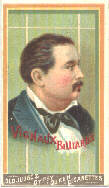
Balkline and straight rail
Encyclopedia

The balkline games developed to make the precursor game, straight rail, more difficult to play and less tedious for spectators to view in light of extraordinary skill developments which allowed top players to score a seemingly endless series of points with the balls barely moving in a confined area of the table playing area. Straight rail, unlike the balkline games, had no balk space restrictions, although one was later added. The object of the game is simple: one point, called a "count", is scored each time a player's cue ball makes contact with both object balls (the second cue ball and the third ball) on a single . A win is achieved by reaching an agreed upon number of counts.
Carom billiards players of the modern era may find it astounding that balkline ever became necessary given the considerable difficulty of straight rail. Nevertheless, according to Mike Shamos, curator
Curator
A curator is a manager or overseer. Traditionally, a curator or keeper of a cultural heritage institution is a content specialist responsible for an institution's collections and involved with the interpretation of heritage material...
of the U.S. Billiard Archive, "the skill of dedicated players [of straight rail] was so great that they could essentially score at will." The story of straight rail and of the balkline games are thoroughly intertwined and encompass a long and rich history, characterized by an astounding series of back and forth developments, akin to a billiards evolutionary arms race
Evolutionary arms race
In evolutionary biology, an evolutionary arms race is an evolutionary struggle between competing sets of co-evolving genes that develop adaptations and counter-adaptations against each other, resembling an arms race, which are also examples of positive feedback...
, where new rules would be implemented to make the game more difficult and to decrease high runs to keep spectators interested, countered by new shot inventions and skills interdicting each new rule.
The rise and "fall" of straight rail
Straight rail, from which the balkline games derive, sometimes called carom billiards, straight billiards, the three-ball game, the carambole game, and the free game in EuropeEurope
Europe is, by convention, one of the world's seven continents. Comprising the westernmost peninsula of Eurasia, Europe is generally 'divided' from Asia to its east by the watershed divides of the Ural and Caucasus Mountains, the Ural River, the Caspian and Black Seas, and the waterways connecting...
, is thought to date to the 18th century, although no exact time of origin is known. It was known as French caroms, French billiards, or the French game in early times, taking those bygone names from the French who popularized it. The derivation
Etymology
Etymology is the study of the history of words, their origins, and how their form and meaning have changed over time.For languages with a long written history, etymologists make use of texts in these languages and texts about the languages to gather knowledge about how words were used during...
of the name straight rail is not clear. An early mention appears in the March 23, 1881 edition of The New York Times
The New York Times
The New York Times is an American daily newspaper founded and continuously published in New York City since 1851. The New York Times has won 106 Pulitzer Prizes, the most of any news organization...
wherein it is referred to as "the straight rail game."
At straight rail's inception there was no restriction on the manner of scoring, such as a number of cushions that must be contacted on a shot, as in the game of three cushion billiards, nor a requirement that the balls leave a region of the table, as in the balkline games.
In 1855, the first public stakes straight rail match in the U.S. took place in San Francisco. The contestants, Michael Phelan and a Monsieur Damon of Paris battled for seven hours, but the high run, set by Phelan, was just nine points. A technique soon developed, known as crotching, vastly increasing counts. The crotch refers to the space at the corner of a table where the rails meet. By freezing the two object balls into the crotch, a player could endlessly score off them, all the while keeping them immobilized in that corner.
Crotching was quickly banned in 1862. Under the prohibitive rule (the first use of a balk space), the crotch was defined as the triangular region found by connecting a line between the points measuring 4½ inches down each rail forming the corner, and in which only three counts could be scores before at least one ball had to be driven away. The no crotching rule is still in place in the official rules for straight rail promulgated by the Billiard Congress of America
Billiard Congress of America
Billiard Congress of America is a governing body for cue sports in North America , the regional member organization of the World Pool-Billiard Association...
, the governing body of billiards
Billiards
Cue sports , also known as billiard sports, are a wide variety of games of skill generally played with a cue stick which is used to strike billiard balls, moving them around a cloth-covered billiards table bounded by rubber .Historically, the umbrella term was billiards...
in the United States.
Straight rail became progressively more popular and skill in the game increased commensurately. For example, Albert Garnier, author of Scientific Billiards (1880) and the champion of the first world title straight rail tournament in 1873, averaged 12 points over the course of the competition and posted a high run of 113. Although unimpressive compared with later records (in 1931 legendary player Charlie Peterson achieved an astounding 10,232 high run count), the many-fold increase in scoring average and high run as compared with the 1855 contest was a result of refinement of gather shots and, most importantly, the development of a variety of "nurse" techniques (also called nursery cannons in the UK).
A gather shot refers to a shot in which the intent is to bring the cue ball and object balls together, ideally near a rail. A nurse describes fine, close-quarters manipulation of object balls once gathered near a rail, which results in both balls being touched by the cue ball, but with all three balls , or that result in a position that can be duplicated over and over.

Billiard Techniques
Cue sports techniques are an immensely important aspect of game play in the various cue sports such as carom billiards, pool, snooker and other games...
involved in maintaining a nurse, as well as in fixing a nurse or gathering again when a nurse breaks down too far for recovery.
At the U.S. straight rail professional tournament held in 1879, Jacob Schaefer, Sr.
Jacob Schaefer Sr.
Jacob Schaefer, Sr. , nicknamed "the Wizard", was a professional carom billiards player, especially of the straight rail and balkline games, and was posthumously inducted into the Billiard Congress of America Hall of Fame in 1968....
scored 690 points in a single at the table (with the prohibition against crotching in place). With the balls barely moving and repetitively hit, there was little for the fans to watch. Schaefer was quickly "hailed as 'the wizard'... Billiards officials, recognizing that Schaefer was a peerless performer in "nursing," wrote an 8 inch balkline into the rules..."
This marked the demise of professional straight rail in the U.S., which only had a six year run from 1873 to 1879. Meanwhile, straight rail professional play continued in Europe, with high run counts consistently climbing. Frenchman
French people
The French are a nation that share a common French culture and speak the French language as a mother tongue. Historically, the French population are descended from peoples of Celtic, Latin and Germanic origin, and are today a mixture of several ethnic groups...
Maurice Vignaux posted a 1,531 count in Paris in 1880, while American
United States
The United States of America is a federal constitutional republic comprising fifty states and a federal district...
George Spears had a high run of 5,041 in 1890. Later runs of over 10,000, in addition to the one previously noted, have been accurately reported.
Today, straight rail play is relatively uncommon in the U.S. but retains popularity in Europe, where it is considered a fine practice game for both balkline and three cushion billiards. Additionally, Europe hosts professional competitions known as pentathlon
Pentathlon
A pentathlon is a contest featuring five different events. The name is derived from Greek: combining the words pente and -athlon . The first pentathlon was documented in Ancient Greece and was part of the Ancient Olympic Games...
s after the ancient Greek
Ancient Greece
Ancient Greece is a civilization belonging to a period of Greek history that lasted from the Archaic period of the 8th to 6th centuries BC to the end of antiquity. Immediately following this period was the beginning of the Early Middle Ages and the Byzantine era. Included in Ancient Greece is the...
Olympic competitions, in which straight rail is featured as one of five billiards disciplines at which players compete, the other four being 47.1 balkline, cushion caroms
Cushion caroms
Cushion caroms sometimes called by its original name, the indirect game, is a carom billiards discipline generally played on a cloth-covered, 5 foot × 10 foot, pocketless table with two cue balls and a third red-colored ball...
, 71.2 balkline and three-cushion billiards
The ascendancy of balkline
The new game appearing in 1879, called the champion's game or limited-rail, is considered an intermediary game between straight rail and balkline and was designed with the specific intent of frustrating the rail nurse. The game employed diagonal lines – balklines – at the table's corners to regions where counts were restricted, thus "cutting off four triangular spaces in the four corners, [taking] away 28 inches of the 'nursing' surface of the end rails and 56 inches on the long rails."Reporting on the first tournament at which the champion's game was featured in 1879, sponsored by H. W. Collender, the New York Times wrote: "taken as a test, the games thus far played indicate that the new game has taken well with the public, for whose amusement it was chiefly designed. That the rules binding it have effected a great improvement on the ordinary game of French caroms there can be no doubt."
Despite its divergence from straight rail, the champion's game simply expanded the dimensions of the balk space defined under the existing crotch prohibition. The aim of stopping the rail nurse was not successful. Jacob Schaefer, Sr. the same player whose 690 count was in large part responsible for the institution of new rules, in short order developed a technique allowing him and other players to reverse the direction of the rail nurse. The balls could thus be endlessly nursed down the rail, reversed in orientation, and nursed the opposite direction without ever even entering the expanded balk space.

For the most part, the differences between one balkline game to another is defined by two measures: 1) the spacing of the balklines, and 2) the number of points that are allowed in each balk space before at least one ball must leave the region. Generally, balkline games, and their particular restrictions, are given numerical names indicating both of these characteristics; the first number indicated either inches or centimeters depending on the game, and the second, after a dot, indicates the count restriction in balk spaces, which is always either one or two. For example, in 18.2 balkline, one of the more prominent balkline games and of U.S. origin, the name indicates that balklines are drawn 18 inches distant from each rail, and only two counts are allowed in a balk space before a ball must leave. By contrast, in 71.2 balkline, of French invention, lines are drawn 71 centimeters distant from each rail, also with a two count restriction for balk spaces.

Balklines did not stop the rail nurse but they did restrict its use. Soon a new type of nurse was developed which exploited a loophole in balkline rules: so long as both object balls straddled a balkline, there was no restriction on counts, as each ball lay in a separate balk space. The new technique, deemed the anchor nurse, again increased runs greatly. The anchor nurse is a stationary shot in which both object balls, falling on either side of a balkline, are hit repeatedly without moving—they are "anchored" in place. Once again a new rule was necessary to combat this new skill development; thus arose the Parker's box in 1894.
Named after Chicagoan J. E. Parker, the tournament director who suggested it after Jacob Schaefer, Sr. and Frank C. Ives both posted extensive runs at his room
Pool hall
A billiard/billiards, pool or snooker hall is a place where people get together for playing cue sports such as pool, snooker or carom billiards...
using the anchor nurse, the Parker's box is a rectangular marking straddling the spot where the balkline meets each rail. Enclosing a space 3½ inches out from the rail and 7 inches across, the box marks a region where both balls are considered in balk, despite that the object balls may technically fall on either side of a balkline. When first instituted, ten shots were allowed while the balls were inside the Parker's box or "in anchor". This was reduced to five in 1896 when 18.2 balkline was gaining popularity.
True to form, the next skill development response was the chuck nurse, known as a rocking cannon in the United Kingdom
United Kingdom
The United Kingdom of Great Britain and Northern IrelandIn the United Kingdom and Dependencies, other languages have been officially recognised as legitimate autochthonous languages under the European Charter for Regional or Minority Languages...
. With one ball frozen to the cushion in the Parker's box, but the second object ball away from the rail just outside the borders of the Parker's box, the cue ball is gently rebounded off the ball not moving it, but with just enough speed to meet the other object ball which rocks in place, but does not change position. In 1912, playing 18.2 balkline, William A. Spinks
William A. Spinks
, known professionally as or , and occasionally also referred to as ), was an American professional player of carom billiards in the late 19th and early 20th centuries...
ran 1,010 continuous points using the chuck nurse and broke off his run without ever missing.
There were a number of proposals to curtail the chuck nurse's effectiveness, including removing the four balk spaces on the end rails where dominant players in the 1920s such as Willie Hoppe
Willie Hoppe
William Frederick Hoppe , known predominantly as Willie Hoppe , was an internationally renowned American professional carom billiards champion, who was posthumously inducted into the Billiard Congress of America Hall of Fame in 1966.-Biography:Hoppe was born in Cornwall on Hudson, New York on...
, Welker Cochran
Welker Cochran
Welker Cochran was an American professional carom billiards player who won world titles in two different disciplines, balkline and three-cushion billiards.-Biography:He was born in Manson, Iowa...
and Jake Schaefer, Jr
Jacob Schaefer Jr.
Jacob Schaefer, Jr. was a professional carom billiards player, a specialist in balkline games, and was inducted into the Billiard Congress of America Hall of Fame in 1968.-Professional career:...
, (Jacob Sr.'s son) had perfected their nursing skills, but leaving balk spaces in place on the .
The solution ultimately reached, and the change that brought the general rules of balkline into configuration with what is played today, was the establishment of eight anchor spaces. The anchor space is simply a doubling of the Parker's box to 7 inches distant from the rail and 14 inches parallel
Parallel (geometry)
Parallelism is a term in geometry and in everyday life that refers to a property in Euclidean space of two or more lines or planes, or a combination of these. The assumed existence and properties of parallel lines are the basis of Euclid's parallel postulate. Two lines in a plane that do not...
to the rail; simple, but placing the chuck nurse out of reach. The new restriction was instituted for a 1914 tournament, the first in 14.1 balkline, specifically to curtail the chuck nurse.
Over its history balkline has had many variations including 8.2, 10.2, 12.2, 12½.2, 13.2, 14.1, 14.2, 18.1, 18.2, 28.2, 38.2, 39.2, 42.2, 45.1, 45.2, 47.1, 47.2, 57.2 and 71.2 balkline. In its various incarnations, balkline was the predominant billiards discipline from 1883 to the 1930s when it was overtaken by three cushion billiards and pocket billiards
Pocket billiards
Pool, also more formally known as pocket billiards or pool billiards , is the family of cue sports and games played on a pool table having six receptacles called pockets along the , into which balls are deposited as the main goal of play. Popular versions include eight-ball and nine-ball...
. Balkline is not very common in the U.S. but still enjoys a large popularity in Europe and the Far East
Far East
The Far East is an English term mostly describing East Asia and Southeast Asia, with South Asia sometimes also included for economic and cultural reasons.The term came into use in European geopolitical discourse in the 19th century,...
.

